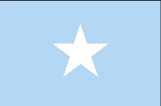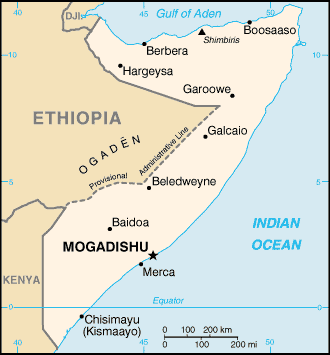|
Somalia
|

|
Capital: Mogadishu
Population: 15,442,905
Brief History of Somalia:
Somalia is located on the horn of Africa. Influences from both African and Arabia are prevalent. There were several different Somali empires during the Middle Ages that had a large impact on trade in the area due to Somalia's important location between Africa and Arabia. These empires included the Sultanate of Adal, the Warsangali Sultanate, and the Gobroon Dynasty.
In the 1800s the British and the Italians arrived. They established British Somaliland and Italian Somaliland. The Dervishes, under Muhammad Abdullah Hassan, fought off the British from the interior of Somalia for years until they were defeated in 1920. The area was mostly controlled by Italy until after World War I, when the British took over the entire area. In 1960 the independent nation of Somalia was formed.
In 1991 the Somali civil war broke out. Since that time the country has been in anarchy with no real central government. As a result, it is one of the world?s most violent and poorest countries.
The Geography of Somalia
Total Size: 637,657 square km
Size Comparison: slightly smaller than Texas
Geographical Coordinates: 10 00 N, 49 00 E
World Region or Continent: Africa
General Terrain: mostly flat to undulating plateau rising to hills in north
Geographical Low Point: Indian Ocean 0 m
Geographical High Point: Shimbiris 2,416 m
Climate: principally desert; northeast monsoon (December to February), moderate temperatures in north and very hot in south; southwest monsoon (May to October), torrid in the north and hot in the south, irregular rainfall, hot and humid periods (tangambili) between monsoons
Major cities: MOGADISHU (capital) 1.353 million (2009), Bosaso
The People of Somalia
Type of Government: no permanent national government; transitional, parliamentary federal government
Languages Spoken: Somali (official), Arabic, Italian, English
Independence: 1 July 1960 (from a merger of British Somaliland, which became independent from the UK on 26 June 1960, and Italian Somaliland, which became independent from the Italian-administered UN trusteeship on 1 July 1960, to form the Somali Republic)
National Holiday: Foundation of the Somali Republic, 1 July (1960); note - 26 June (1960) in Somaliland
Nationality: Somali(s)
Religions: Sunni Muslim
National Symbol: leopard
National Anthem or Song: Soomaaliyeey toosoo (Somalia Wake Up)
Economy of Somalia
Major Industries: a few light industries, including sugar refining, textiles, wireless communication
Agricultural Products: bananas, sorghum, corn, coconuts, rice, sugarcane, mangoes, sesame seeds, beans; cattle, sheep, goats; fish
Natural Resources: uranium and largely unexploited reserves of iron ore, tin, gypsum, bauxite, copper, salt, natural gas, likely oil reserves
Major Exports: livestock, bananas, hides, fish, charcoal, scrap metal
Major Imports: manufactures, petroleum products, foodstuffs, construction materials, qat
Currency: Somali shilling (SOS)
National GDP: $5,896,000,000
** Source for population (2012 est.) and GDP (2011 est.) is CIA World Factbook.
Back to Geography Home Page
